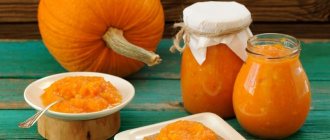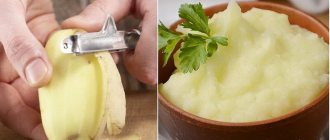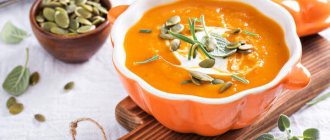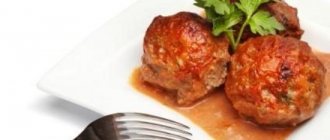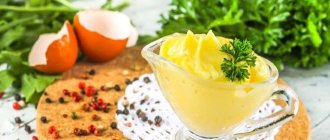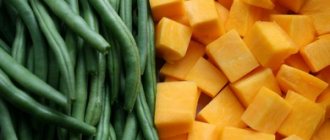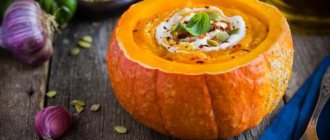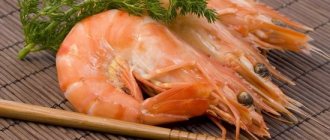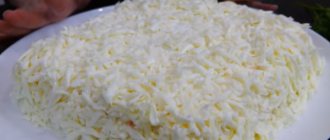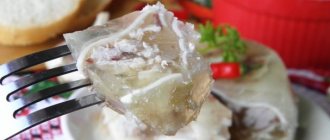Category: Dishes for children
Many children don't like vegetables. And you can’t force a child to eat them, even if you dance or sing. But for some reason my kids really liked this recipe. Try it, maybe yours will appreciate it too.
This vegetable casserole can be served separately or used as a side dish. Suitable for children from 1 year old, but earlier if you do not use milk. Vegetables can be replaced with others, for example, cauliflower or broccoli. It all depends on what your child likes. This dish will significantly diversify baby food, and it won’t take much time to prepare.
Ingredients:
- Zucchini – 200 g
- Pumpkin – 200 g
- Milk – 100 ml
- Egg – 1 pc.
- Salt, sunflower oil - optional
Preparing the recipe step by step:
Prepare the vegetables: wash, peel, cut into cubes. I had frozen ones, but they were my own.
Fill with water and bring to a boil, cook for 5-7 minutes. They should be a little undercooked.
Place on a sieve and let the water drain so that the casserole does not spread.
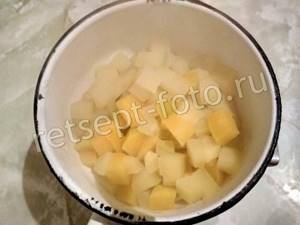
Place in a baking dish. If desired, add salt and oil.
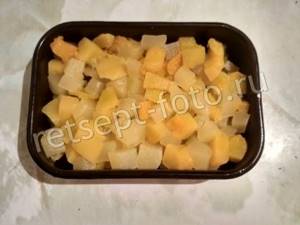
Shake the egg with milk.
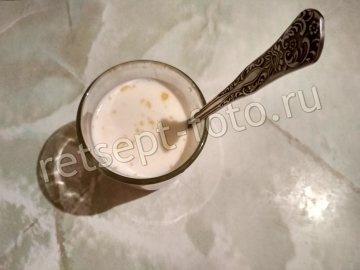
Pour this mixture over the vegetables.
Place in a preheated oven at 180 C for 15-20 minutes.
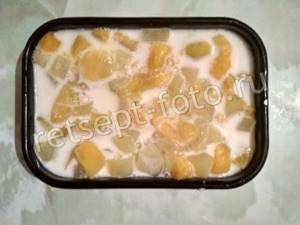
There is no need to keep it in the oven for a long time until a crust forms, since we are preparing it for children.
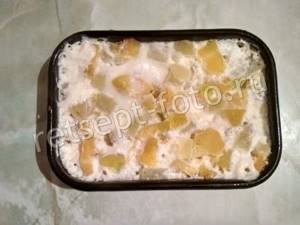
Let cool slightly and cut into portions.
Pumpkin is a product that has been known to people for a long time. Scientists have found that the American Indians cultivated this “berry” (from the point of view of botanists, it is a berry, not a vegetable, although we usually call it that) and knew the recipe for how to prepare it five thousand years ago. You can add cereal or zucchini to the pumpkin puree recipe. Other berries or fruits can also complement the recipe. The beneficial properties of the appetizing fatty milk explain its use for children's and dietary nutrition. Pumpkin puree for a child can be either one-component or with the addition of other products.
How to make pumpkin puree
Its pulp contains a lot of useful things - vitamins A, C, E, F, PP, B vitamins, fiber necessary for the normal functioning of the stomach, pectins, a whole warehouse of minerals and trace elements: iron, potassium, calcium, copper, phosphorus, zinc and Vitamin C is especially necessary for the growth and development of a child. And mothers like that they don’t need to think too much about how to prepare pumpkin puree - it’s very easy and quick.
Due to its valuable properties and easy digestibility, pumpkin puree, like puree containing zucchini, is recommended by nutritionists and pediatricians as a recipe for the first complementary foods a baby receives. Of course, you should observe your child’s reaction to new food. But, as a rule, there are practically no problems with allergies, especially if new complementary foods are introduced gradually. Orange beauty and zucchini are also used in recipes for older children.
Subscribe to Baby Feeding on YouTube!
How to choose the right pumpkin
Pumpkin puree for babies - how to prepare
Today you can find different types of vegetables:
- “Halloween” is a classic and familiar form;
- Gray;
- "Guitar".
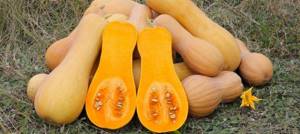
Muscat pumpkin variety "Guitar"
All three are suitable for soup; you should choose according to individual preferences. There are several recommendations on how to choose the right pumpkin:
- It should not be too large in size, as this can result in either too dry or, conversely, watery pulp.
- There should be no damage to the peel.
- If the vegetable is cut, then you should take the part that has very bright flesh - this indicates a high amount of carotene in it.
- You cannot store the cut product; it is better to use the entire piece or freeze the rest.
Pumpkin puree recipe
Zucchini - 100 gr.
Milk - 1 glass
Butter - 10-20 gr.
Salt - to taste (for children under one year old it is better not to add salt)
Rinse the vegetables thoroughly, remove skins and seeds, and cut into small pieces.
Place the prepared pieces in a saucepan, add milk, salt and cook for 25-30 minutes over low heat.
Puree the prepared vegetables in a blender, add the oil included in the recipe and transfer to a plate.
Pumpkin is a tasty and easy to prepare product. Due to its many beneficial properties, it is an ideal complementary food for infants. Pediatricians recommend introducing puree from this vegetable into the diet for up to a year.
Recipe seven: puree with pear
Ingredients:
• 50 ml water; • 150 g pumpkin; • 100 g pear; • sugar.
Preparing a delicious dish for babies:
1. Wash and peel the pumpkin. Then cut the pieces. Then fill the pumpkin with water and cover with a lid. Simmer for twenty minutes until soft.2. Then wash and peel the pear. Next, cut into small pieces.3. Then combine the pumpkin and pear, blend in a blender until pureed. If you want, you can sweeten the dish for your child a little.
Benefits of pumpkin for babies
It’s not for nothing that pumpkin is one of the first to be introduced into complementary foods. Due to its high water content, as well as a complex of vitamins and minerals, it has a positive effect on the growing body:
- beta-carotene - responsible for vision and cleanliness of the skin;
- vitamin E - helps normalize protein and fat metabolism, improves the absorption of vitamin A, and is also an antioxidant;
- Vitamin C - strengthens the immune system, helps fight viruses and various infections;
- vitamins B6, B1 and B2 - strengthen the nervous system;
- vitamin K - responsible for cell growth and blood clotting;
- vitamin T - helps build muscle mass;
- vitamin D - prevents the development of rickets;
- iron - participates in the process of hematopoiesis, fights weakness, fatigue, anemia;
- potassium - removes excess fluid from the body, relieves swelling;
- fiber - normalizes intestinal motility, helps fight constipation;
- pectins - remove toxins and improve the functioning of the digestive system.
When should you give up pumpkin?
The product is strictly prohibited from being introduced into the diet in the following cases:
- individual intolerance;
- diabetes;
- diseases of the digestive system;
- intestinal colic.
Individual reaction to pumpkin: how allergenic is the vegetable?
Despite the undoubted benefits of pumpkin for the body, it should be remembered that excessive consumption of this product can cause intestinal upset and lead to “carotene jaundice.” It manifests itself in yellowing of the palms and sclera of the eyes of the feet.
The carotene content in pumpkin is no less than in carrots, so the baby may develop an allergy.
How often to give, quantity
In the first year, a child’s body is still adapting to external conditions, so you need to be very careful with the first complementary foods or introduction to a product. Even if the baby already knows the taste of all the ingredients of the soup, their combination can cause an unexpected reaction. You should not ask your child to eat the entire bowl at once at lunch.
You should always start complementary feeding with half a teaspoon in the morning. If by the evening there are no reactions, then the next day you can give a whole spoon. So the serving size gradually increases, by the year it is 180-200 ml.
Note! If suddenly the baby ate a little more or less than he was offered, there is nothing to worry about. Dr. Komarovsky, a famous Russian pediatrician, claims that the baby can regulate the amount of food he receives.
Soup can be offered daily - such food is easily digestible, and the liquid will help in establishing digestive processes. The main thing is not to cook soup with pork or add any spices.
Industrial production or home preparation
You don't have to make your own pumpkin puree. It is sold in the children's section of any supermarket. But is it possible to be completely confident in the quality of the finished product? Besides, food made with love by mom always tastes better.
When preparing pumpkin at home, it is important to choose the right fruit. This will help knowing simple rules:
- the peel should be smooth, without rot or visible damage, the tail should be dry;
- to start complementary feeding, it is better to take a fruit with a peel that is not too brightly colored (the brighter the color, the greater the likelihood of allergies);
- weight should not exceed 3.5–5 kg.
By choosing and preparing the pumpkin yourself, mom can be sure that she will feed her baby a healthy diet.
Homemade pumpkin puree does not contain preservatives or other substances that can cause an allergic reaction in a baby.
Mashed potatoes for first feeding, basic recipe
To prepare pumpkin when your child is 6 months old as complementary food, you will need to take the following ingredients: 0.5 kg of orange vegetable, at least 150 ml of water.
The raw vegetable is peeled from the outer peel and inner seeds, it is advisable to remove all the fibers. The purified product is cut into arbitrary cubes or pieces. The preferred size for making purees is 2 by 2 cm.
The prepared pieces are laid out in 1 layer at the bottom of the pan. From above they are filled with hot or boiling water. It is necessary to pour in such a volume of water that it completely covers the cubes. The cooking process is carried out under a closed lid.
It is impossible to determine the cooking duration in advance. It depends on the consistency of the fruit. You should try the vegetable for readiness for the first time after 15-20 minutes. To do this, the product is pierced with a knife or fork. If the vegetable sits tightly on the tip, you need to cook it more, it rolls off easily - the dish is ready.
Every kitchen has modern chopping equipment. A blender is suitable for grinding. The boiled pieces are loaded into a container and crushed to a thick mass, but so that there are no separate dense inclusions in it. If there is no such device, then a simple grater will do.
The resulting mass is given to the child from a spoon. Prepared puree for children can be stored in the refrigerator for 3-5 days. But to do this, it needs to be placed in small, hermetically sealed containers. The finished product is frozen. In this form, it completely retains its color, taste and nutrients.
Rules for introducing a new product at an early age
Doctors say that early exposure to adult food can negatively affect the health of the baby, namely, cause allergic dermatitis. Parents should remember that any change in diet is stressful for the baby, so complementary feeding begins with small portions. Pumpkin puree is introduced into the diet with half a teaspoon, and the juice with a few drops, then supplemented with breast milk or formula. If no negative reactions to the product are observed, the next day the portion is doubled and gradually brought to the age norm.
At what age can you start giving pumpkin to your baby?
Pediatricians recommend introducing pumpkin into the diet of healthy children from 6 months. If the baby has a tendency to allergic reactions, the start of complementary feeding is delayed until 8 months.
You should introduce the baby to pumpkin after the baby tries zucchini, cauliflower, and broccoli. These are vegetables with a low allergenicity index. In addition, the baby is unlikely to want to eat them after sweet pumpkin.
How often to give a vegetable
After the baby gets used to the new product, it can be given in the form of a one-component puree (without adding other vegetables or fruits). Don’t get carried away and feed your child pumpkin every day - 2 times a week is enough. No more than 1 teaspoon as an additive to porridge or other dishes can be given every day.
Doctors recommend introducing pumpkin into the diet of a healthy baby from 6 months.
Basic recommendations for introducing foods into a child’s diet
These rules apply not only to pumpkin, but also to other dishes that the child tries as complementary foods:
- a new product is given only if the baby is absolutely healthy;
- it is better to do this in the first half of the day;
- The child should be fed not from a bottle, but from a spoon;
- You should not introduce your baby to a new product a week before and a week after vaccination;
- complementary feeding should be started with liquid puree or vegetable juice;
- food temperature should be 37–39 0.
At least two weeks should pass between introducing new foods into the diet.
Video: Doctor Komarovsky about the beginning of complementary feeding
When to introduce into complementary foods
Pumpkin puree soup for children usually contains other vegetables: potatoes, zucchini. Therefore, it is worth introducing the dish when the baby has already tried other cultures.
Since pumpkin can cause allergies in some cases, it should not be included in the first complementary foods. At 6 months, the child is offered to try zucchini, cauliflower, broccoli - hypoallergenic foods.
Important! If the baby is bottle-fed, then complementary feeding can be started at 4.4-5 months.
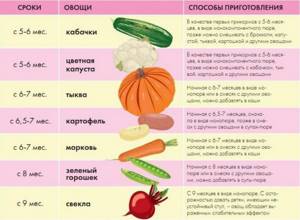
As a rule, a child first tries pumpkin dishes at 7 months. Usually this is a homogeneous puree, which is diluted either with breast milk or an adapted formula.
Children's food recipes
As new products appear in the diet, pumpkin dishes become more varied.
With yolk
- Prepare pumpkin puree as usual.
- Separately boil the chicken egg, separate the yolk and add it to the pumpkin mixture.
- Beat with a blender.
- Add 3-5 drops of vegetable oil.
- To keep the puree from being too thick, you can dilute it with formula or breast milk.
With dill
Pumpkin puree with dill helps normalize digestion, relieves bloating and colic.
- Prepare pumpkin puree according to the basic recipe.
- Wash the dill sprig and finely chop it (do not use the stem).
- Mix the ingredients into a homogeneous mass.
- If the puree is thick, add breast milk or formula.
With apple or pear
- Place the prepared fruits and pumpkin in equal proportions in a saucepan and add water.
- Cook for at least 20 minutes (until soft). If you cook food in a multicooker in the “stew” mode, the cooking time increases to 30 minutes, if you use a double boiler - up to 25 minutes.
- Carefully drain off excess water.
- Grind the mixture through a sieve or blender.
With dried apricots
Eating dried apricots helps increase hemoglobin, normalizes the immune system, and improves the functioning of the heart and digestive tract. The baby is introduced to this product no earlier than 10–11 months. As a rule, allergies to it do not occur if you do not exceed the recommended amount of the product (up to 50 grams per day).
To ensure that dried fruits soften well, they are soaked in cold water at least 12 hours before cooking. It's better to do this at night.
- Boil 3-4 pieces of dried apricots for 1-2 minutes.
- Grind through a sieve.
- Prepare the pumpkin in the usual way and combine with dried apricot puree.
Giving pumpkin puree with dried apricots more than 2 times a week is not recommended, as this can lead to severe loosening of the stool.
With meat
- Boil 50 g of turkey or chicken.
- Separately, cook chopped pumpkin (150 g).
- Combine the ingredients, beat with a blender or grind through a fine sieve.
- Add a few drops of vegetable oil.
With rice
Nutritionists advise starting complementary feeding with rice porridge. It does not injure the delicate gastric mucosa and quickly restores energy. In addition, this cereal does not contain gluten (gluten), so it is considered hypoallergenic.
- Rinse 1.5 tablespoons of rice under running water until it becomes clear.
- Boil the rice in a glass of water until tender.
- Cool and grind through a sieve.
- Combine with prepared pumpkin puree.
- Beat the mass with a blender.
With zucchini
- Prepared pieces of pumpkin and zucchini (without peel and seeds) in equal proportions (100 g each), add water, boil until soft.
- Drain off excess liquid.
- Grind the mixture through a sieve.
- Add milk or mixture.
Recipes for children under one year old
Each mother decides for herself when to start giving juice to her baby, but pediatricians recommend introducing vegetable and fruit juices no earlier than 6-9 months.
carrot juice
There is virtually no benefit to carrot juice unless it is consumed with butter. Fat-soluble vitamin A simply cannot be absorbed into the body without an oil supplement. So we take the carrots, peel them from the tops and skins, rinse them thoroughly under running cold water and chop them. To chop a vegetable, you need to puree it in a blender or simply grate it on a fine grater. Then strain the carrot puree through 2-3 layers of gauze, add a drop of vegetable or olive oil and give the juice to the child.
This juice cannot be stored, as it does not contain preservatives, so prepare it for one serving, or drink the leftovers yourself.
Apple juice
Apple juice is the safest, hypoallergenic, and therefore often the first thing in a baby’s life. But, nevertheless, this juice should still be given gradually: we start with a couple of drops in between feedings and finish by giving the child the daily dose of juice with pulp.
So, for apple juice, the fruits must be peeled and passed through a juicer, blender, or at least grated on a fine grater. The resulting pulp should be separated from the pulp by passing through 5-6 layers of gauze.
It is with vegetable puree soups that children's doctors recommend starting complementary feeding for a child from 6 months. Vegetables must be introduced gradually, one type every few days. Several simple recipes for making light vegetable soups for children.
Vegetable puree soup for children
Ingredients:
- water - 200 ml;
- carrots - 0.5 pcs.;
- potatoes - 1 pc.;
- onion - 0.5 pcs.
Preparation
We thoroughly wash the vegetables, peel them, finely chop them and place them in a double boiler or a small enamel saucepan. Then pour in boiled water and cook until fully cooked under the lid. Next, carefully remove the vegetables, puree them in a blender and dilute them with vegetable broth. After this, bring the finished soup to a boil, adding a little butter or olive oil if desired.
Vegetable soup for children with fish
Ingredients:
- potatoes - 1 pc.;
- carrots - 1 pc.;
- onion - 1 pc.;
- cauliflower - 50 g;
- broccoli cabbage - 50 g;
- hake fillet - 40 g.
Preparation
Throw the fish fillet into boiling water and cook it for about 20 minutes with the lid closed. Meanwhile, we clean the vegetables, wash them and cut them into small cubes. After the required time has passed, pour them into the pan and let them cook for another 20 minutes, stirring occasionally. Beat the finished soup with a blender and pour into a plate.
Vegetable soup for children
Ingredients:
- carrots - 3 pcs.;
- zucchini - 1 pc.;
- cauliflower - 200 g;
- frozen green peas - 0.5 tbsp.;
- water;
- boiled rice - 0.5 tbsp;
- spices.
Preparation
Pour filtered boiled water into a saucepan, place on medium heat and heat to a boil. During this time, we prepare the vegetables: peel the potatoes, cut them into small cubes and throw them into boiling water. Peel the carrots and chop them into small slices or three on a grater. We also throw it into the pan, cover with a lid and cook for 5 minutes.
Then we divide the cauliflower into small inflorescences. Peel the zucchini and chop into cubes. Next, put the prepared vegetables in the pan, add green peas, add a little salt and mix. Close the pan with a lid again, cook for another 10 minutes over medium heat, and then beat thoroughly with a blender and pour the vegetable broth soup into children's plates.
For a child under one year old, it is recommended to give zucchini puree in its pure form, and for older children - with different ingredients: butter, sugar, egg, herbs, vegetables, fruits or cereals. Zucchini is considered one of the healthiest foods for children, because... it is easily digestible and contains a large amount of vitamins, salts, iron and calcium.
How to make zucchini puree?
There are general principles for preparing vegetable puree from zucchini:
- Choose the right vegetables. Both zucchini and regular zucchini are suitable. Vegetables must be young, always with whole skin.
- Wash the zucchini, cut off the skin, remove the seeds from the vegetable and soak for two hours.
- Prepare in any way: boil in water or a double boiler, simmer, bake in the oven. It will be ready in 15-20 minutes.
- Mix with additional ingredients according to recipe.
- Rub through a sieve or grind with a blender.
Recipes for baby zucchini puree
Zucchini puree with semolina
Ingredients:
- 1/3 small zucchini;
- 1 tsp semolina;
- 1 tsp Sahara;
- 1 yolk;
- 5g butter;
- ½ glass of milk.
If a child has an allergy, then milk is replaced with water, semolina with rice flour, sugar with fructose.
Preparation
Finely chop the peeled and soaked zucchini into cubes. Mix milk with yolk, sugar and semolina. Pour this over the zucchini. Set the steamer to “steaming” and leave for 20 minutes. Or cook the drenched zucchini, stirring constantly, over low heat. Grind the finished mixture with a blender. Before serving, add butter to the plate.
Zucchini puree with apple
Ingredients:
- ½ zucchini;
- 1 apple;
- 1 tsp. sugar if the apple is sour.
Preparation
Cut the peeled zucchini and apple into cubes, removing the cores. Cook the vegetables separately (how to cook zucchini puree was mentioned earlier). Combine boiled vegetables and grind. Place on fire and bring to a boil. Then add sugar to taste and cool.
Your child will definitely like zucchini puree prepared according to these recipes.
How to properly prepare mashed potatoes?
- Soak in water for a day, after removing the peel in a thick layer (to remove excess starch).
- Cut and place in an enamel pan with boiling water. Cook covered and bring to a boil over low heat. Do not salt the water.
- Remove the boiled potatoes and chop them in an accessible way while they are hot.
- To form a semi-liquid puree, add a decoction of potatoes and milk.
Mashed potatoes for babies should be lump-free, fluffy, very tender and not thick. Served warm.
Mashed Potato Recipe
Mashed potatoes with herbs:
Ingredients:
- 1 piece of potato;
- 85g cabbage or greens;
- 40g milk or mixture.
Preparation
Cut the prepared potatoes into cubes. Place them in a saucepan with boiling water and cover with a lid, cook for 10 minutes over low heat. Then add chopped greens or cabbage and cook until all the vegetables are soft, another 5-10 minutes. Then drain the water and grind the vegetables with a blender or rub through a sieve, while adding milk, until a puree of the desired consistency is formed.
It is imperative to remember that they begin to introduce the child to potatoes with a teaspoon, to check if the baby is allergic to it. If it doesn’t show up, you can increase the portion. And every time for the baby, the mother should prepare fresh mashed potatoes so as not to harm his health.
Buckwheat is one of the first grains introduced into complementary foods due to the fact that it is a low-allergenic product with low gluten content. Buckwheat porridge is especially loved by mothers of bottle-fed babies: it does not contribute to constipation, which bottle-fed babies are prone to. Buckwheat is rich in calcium, iron, phosphorus, iodine, manganese, vitamins of groups B and PP. Buckwheat is a source of protein containing 18 essential amino acids.
Manufacturers of baby food offer a wide selection of special baby cereals, including buckwheat. But tasty and aromatic, and most importantly - healthy, baby buckwheat porridge is not so difficult to prepare from ordinary cereals.
How to cook buckwheat porridge?
Here is the simplest buckwheat porridge recipe .
To prepare porridge for the little ones, you only need buckwheat itself (light, premium, highly purified) and water, as well as a blender or coffee grinder.
- Sort through the cereal, make sure that there are no unrefined grains or specks left in it. Rinse it thoroughly and dry it.
- Using a blender or coffee grinder, grind the cereal until it is slightly finer than semolina.
- Place 1 teaspoon of ground cereal in a saucepan (preferably thick-walled) and add 100 ml of water.
- Bring to a boil and cook, stirring, over low heat for 15 minutes.
- Cool the finished porridge to 37°C; you can add breast milk or formula.
The porridge according to the recipe described here turns out to be quite liquid; a child can eat it from a bottle with a special nipple for porridge. When the baby learns to eat with a spoon, you can start adding thickness: add 2 teaspoons of cereal per 100 ml of water, etc.
From 7-8 months, babies who are not prone to allergies can add low-fat cow's milk to the porridge; closer to one year, sugar and salt, as well as butter. For younger or allergy-prone children, to improve the taste of buckwheat, you can add fruit puree to the finished porridge. Milk buckwheat porridge for children is prepared according to the same recipe as described above, only instead of water, low-fat cow's milk is used, diluted with water in a 1:1 ratio.
Buckwheat porridge recipe for one-year-old babies
Buckwheat porridge for a one-year-old child can be prepared from unground cereals (provided, of course, that your child has already grown enough teeth to chew such porridge). Here is the prescription.
- 0.5 cups of buckwheat (again, we take only light, well-cleaned premium grade buckwheat), sort, rinse, place in a thick-walled bowl, pour in 1-1.5 cups of water.
- Bring to a boil and drain the first water (this will get rid of the unnecessary bitter taste).
- Fill with water again, bring to a boil and cook over moderate heat, covered, for 20-25 minutes, until the water has completely evaporated and the grains have softened and become completely soft.
- It is better to add a very small amount of sugar (approximately 1 teaspoon) during the cooking process so that the sugar crystals dissolve.
- Add a small piece of butter to the bowl of porridge.
- Cool the porridge to 40-45°C - the child should not get burned!
This porridge can also be prepared with the addition of milk: in this case, the cereal (after the first water has been drained) is poured with a small amount of water (in a ratio of 1:1.5), and after the water has evaporated, milk and sugar are added, and the porridge is brought to readiness . Children over one year of age who are switching to a common table can begin to eat buckwheat porridge with meat and vegetable gravy or as a side dish for steamed cutlets; closer to one and a half years old, you can serve a little gourmet buckwheat with sautéed onions and carrots, pumpkin, adding a few crystals of salt to the dish to improve taste.
Puree is practically the first dish, not counting porridge, introduced into the diet of an infant. Why? Yes, because the child’s body does not yet accept heavy food, so puree is an ideal option for complementary feeding. It is recommended to start complementary feeding for children under one year old with vegetable puree.
Pumpkin is a very tasty and healthy vegetable that retains many vitamins and nutrients even despite heat treatment. Pumpkin puree has a very delicate, sweetish taste, and kids eat it with pleasure. It is best to introduce a child to pumpkin from about 5 months, but for children with allergies it is best to wait until 8 months. This puree goes well with fruits, grains, and meat, so the baby food diet with the addition of pumpkin is quite wide and varied.
Pumpkin puree recipe
Ingredients:
- pumpkin - 200 g;
- formula or breast milk - 40 ml;
- olive oil - 1 teaspoon;
- chicken yolk - optional.
Preparation
Let's look at a simple way to make pumpkin puree.
We wash the pumpkin, carefully remove the peel and seeds and cut into small cubes. After this, put the pumpkin in purified boiling water and cook for about 30 minutes. There should be enough water to completely cover the vegetables. Cool the boiled pumpkin thoroughly, grind it in a blender until smooth and add a little olive oil, milk and boiled egg yolk to it. Mix the entire mixture thoroughly. That's all, baby pumpkin puree is ready! You can also add half a fresh apple to the pumpkin puree, which we add after the pumpkin has become soft and boil for another 10 minutes. (Source www.womanadvice.ru)
How to make preparations: ways to store pumpkins
The whole fruit can be stored well in a dry place for several months. Cut pumpkin withers quickly. In this form, it can only be left in the refrigerator and for no longer than 7 days.
How to freeze a vegetable
Portions for infants are small, so making pumpkin puree for just one serving is quite difficult. Leftovers can be portioned, placed in ice cube trays and frozen. The beneficial and taste qualities of the product will not change. In the future, you will only need to remove the puree from the freezer and add it to other ingredients or simply heat it for 2-3 minutes.
You can also freeze raw fruit. To do this, you need to peel the pulp, cut it into small pieces, place them on a cutting board and place in the freezer for 45–60 minutes. When the pumpkin is frozen, divide it into portioned bags and remove it as needed. The process of preparing dishes from pumpkin frozen raw is no different from the usual process.
Canning
Pumpkin puree can be preserved in jars. To do this you need:
- Wash the fruit, cut off the peel, remove the seeds and cut into pieces.
- Place in a saucepan, add 1 liter of water and add 250 g of brown sugar.
- Let it cook on low heat.
- Wash 200 g of cranberries and squeeze the juice out of the berries.
- Pour the juice into the pumpkin mixture and cook for 20–25 minutes.
- Remove from heat, cool and puree in a blender.
- Boil, put in sterilized jars and roll up.
Pumpkin puree can be preserved and fed to your baby with a healthy product all winter long.
